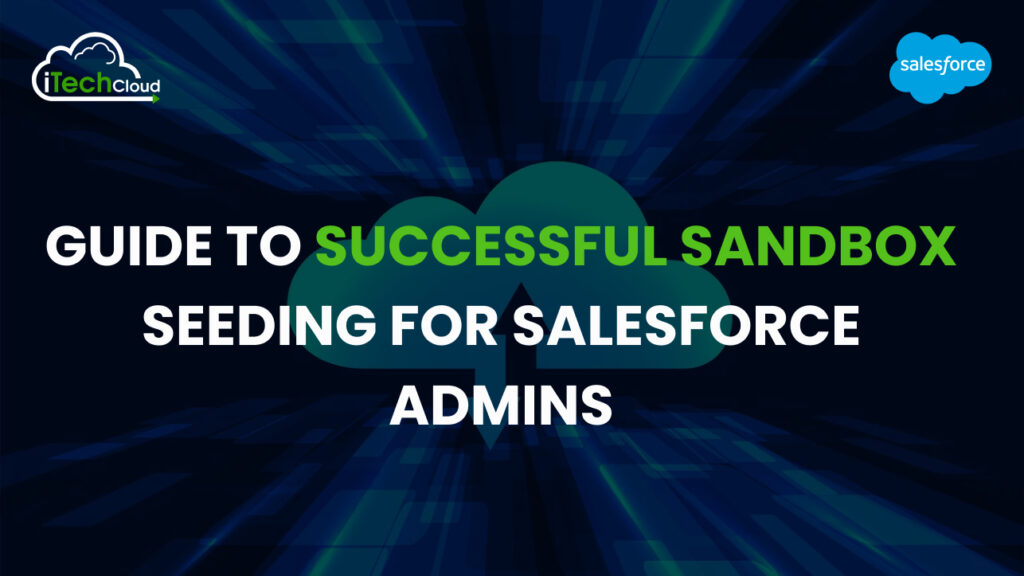Guide to Successful Sandbox Seeding for Salesforce Admins

Introduction
Salesforce sandboxes are essential for testing, development, and training without affecting your production environment. However, simply having a sandbox isn’t enough; seeding it with the right data is crucial for meaningful testing and development.
Sandbox seeding refers to the process of populating a sandbox with relevant data from production or other sources. A well-seeded sandbox ensures that developers, admins, and testers can work in an environment that closely mirrors production, reducing errors and improving efficiency.
By the end, you’ll have a clear roadmap for successful sandbox seeding that enhances your Salesforce development lifecycle.
Table of Contents
1. Types of Salesforce Sandboxes
Salesforce offers different types of sandboxes, each serving a unique purpose:
a) Developer Sandbox
- Purpose: Basic coding and configuration testing.
- Storage: Limited (200MB–500MB).
- Refresh Frequency: Once per day.
- Data: No production data by default (unless manually seeded).
b) Developer Pro Sandbox
- Purpose: More robust development and testing.
- Storage: 1GB.
- Refresh Frequency: Once per day.
- Data: No production data by default.
c) Partial Copy Sandbox
- Purpose: Testing with a subset of production data.
- Storage: 5GB–50GB (depends on org size).
- Refresh Frequency: Every 5 days.
- Data: Includes metadata + a sample of production data (filtered via sandbox template).
d) Full Copy Sandbox
- Purpose: Full-scale testing, UAT, training.
- Storage: Matches production storage.
- Refresh Frequency: Every 29 days.
- Data: Exact copy of production (including all data).
e) Scratch Orgs (For Salesforce DX)
- Purpose: Short-term, disposable environments for CI/CD.
- Storage: Configurable.
- Lifespan: 1–30 days.
- Data: No production data (must be seeded manually).
Choosing the right sandbox depends on your use case. For realistic testing, partial copy and full copy sandboxes are ideal, but they require careful seeding strategies.
2. Why Sandbox Seeding Matters
Without proper seeding, sandboxes become ineffective. Here’s why it’s crucial:
a) Realistic Testing
- Testing with dummy data leads to false confidence.
- Real-world scenarios require real data (or close to it).
b) Data Integrity & Relationships
- Salesforce records have complex relationships (Accounts → Contacts → Opportunities).
- Seeding ensures referential integrity is maintained.
c) Performance Testing
- Large datasets help identify performance bottlenecks.
- Without enough data, you won’t catch slow queries or governor limit issues.
d) Training & Demo Environments
- Training users with real (but anonymized) data improves adoption.
- Demo environments need representative data for client presentations.
e) Compliance & Security
- Sensitive data must be masked or removed in non-production environments.
- Proper seeding ensures GDPR/CCPA compliance.
3. Best Practices for Sandbox Seeding
Follow these best practices to ensure successful sandbox seeding:
a) Define Your Data Requirements
- What objects and fields are needed?
- How much data is enough? (e.g., last 6 months of Opportunities?)
- Should sensitive data be masked?
b) Use Sandbox Templates (For Partial Copy Sandboxes)
- Define filters to include only relevant data.
- Example: Only accounts with “active” status and related contacts.
c) Mask Sensitive Data
- Use Data Mask or third-party tools to anonymize PII (Personally Identifiable Information).
- Helps with compliance (GDPR, HIPAA).
d) Maintain Data Relationships
- Ensure parent-child record hierarchies are preserved.
- Use external IDs or upsert operations to maintain relationships.
e) Automate Where Possible
- Manual seeding is error-prone.
- Use Salesforce APIs, ETL tools, or CI/CD scripts for automation.
f) Document Your Seeding Process
- Keep a record of which data was loaded, when, and how.
- Helps with troubleshooting and audits.
4. Methods for Seeding a Sandbox
There are several ways to seed a sandbox:
a) Manual Data Export/Import (For Small Datasets)
- Export data from production using Data Loader or Reports.
- Import into the sandbox.
- Pros: Simple, no coding required.
- Cons: Time-consuming, error-prone for large datasets.
b) Sandbox Templates (For Partial Copy Sandboxes)
- Define a template during sandbox creation.
- Filters data based on criteria (e.g., “Only accounts created in the last year”).
c) Salesforce APIs (for automation)
- Use Bulk API, REST API, or SOAP API to push data programmatically.
- Example: Apex script that clones production data into a sandbox.
d) ETL Tools (For Complex Data Migration)
- Informatica, MuleSoft, Talend, or Jitterbit can automate data transfers.
- Useful for transforming data before loading (e.g., masking PII).
e) Third-Party Apps
- OwnBackup, Gearset, or Prodly offer sandbox seeding solutions.
- Some include data masking, subsetting, and versioning.
5. Common Challenges & Solutions
a) Missing or Broken Relationships
- Cause: Records loaded without proper lookup fields.
- Solution: Use external IDs and upsert instead of insert.
b) Data Volume Issues
- Cause: Too much data slows down sandbox refreshes.
- Solution: Use Partial Copy sandboxes with filters.
c) Sensitive Data Exposure
- Cause: Production data copied without masking.
- Solution: Use data mask or anonymization tools.
d) Sandbox Refresh Delays
- Cause: Large organizations take longer to refresh.
- Solution: Schedule refreshes during low-usage periods.
6. Automating Sandbox Seeding
Manual seeding is tedious. Automation improves efficiency.
a) Salesforce DX & Scratch Orgs
- Use sfdx commands to push metadata and seed data.
Example:
sfdx force:data:tree:import -f data/Account-Contact.json
b) CI/CD Pipelines
- Jenkins, GitHub Actions, or Azure DevOps can trigger seeding scripts.
c) Scheduled Jobs
- Run Apex or external scripts post-refresh to auto-load data.
Conclusion: Successful Sandbox Seeding for Salesforce Admins
Successful sandbox seeding ensures your Salesforce team works in a realistic, compliant, and efficient environment. By following best practices, defining data needs, using automation, and maintaining relationships you can maximize the value of your sandboxes.

